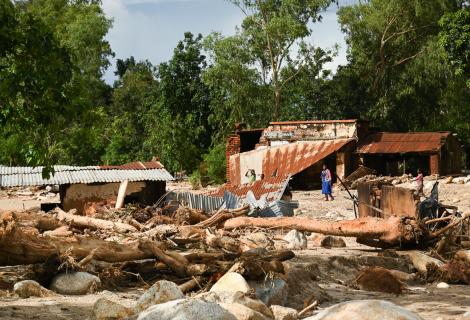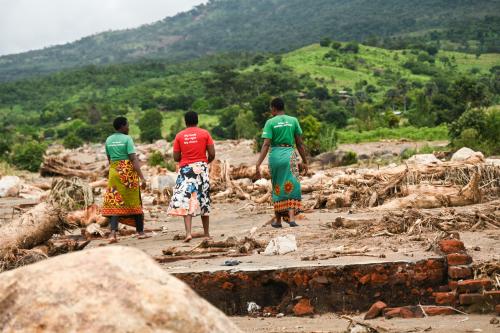Cyclone Freddy: record-breaking destruction

What’s being investigated by some as a record-breaking weather event, has to others caused horror and devastation. #Cyclone Freddy has affected over 1.5 million people in Mozambique, Malawi, and Zimbabwe. We’re working with our teams and partners in each country to support communities whose lives have been changed forever by this cyclone.
The climate crisis is making tropical storms, like Cyclone Freddy, more intense and putting communities on the front lines of climate change at heightened risks. It is often the case that the people having to live through the consequences of a warming planet are the ones who have done the least to cause it, as opposed to hugely polluting nations in the global north.
We look at how each country in the region has been affected:
Mozambique
Before the cyclone hit, Mozambique was already experiencing flooding, leaving over 30,000 people in need of humanitarian assistance. Following Cyclone Freddy‘s first landfall in Inhambane province on 24 February, over 370,000 people were directly affected with 250,000 people displaced across Zambezia, Sofala, Tete, Manica and Niassa provinces. 165 people were killed, 10 injured and more than 30,000 houses were damaged by heavy rains and floods. Following the second landfall (when the cyclone hit again) on 11 March in Namacurra District of Zambezia Province, over 230,000 families, comprising of more than a million people, were directly affected by the flooding and strong winds, which also resulted in 620 injuries and 288 deaths. More than 37,000 houses were flooded in the provinces affected by the cyclone and an additional 74,590 were partially destroyed while more than 104,000 houses completely destroyed About 391,442 hectares of cropland area was also affected of which 134,616 hectares were completely destroyed, with 31,163 hectares flooded. The effect on livelihoods has also been significant with 31,348 poultry projects and 1,089 animals being lost, 1,747 fishing projects and 265 vessels being affected, of which 86 vessels were completely destroyed. In addition, around 1,000 schools were damaged by the cyclone which has affected more than 1.2 million school children and around 14,000 teachers. The cyclone also destroyed 485 religious buildings, 414 power transformers and 125 health facilities.
The road network in the country was adversely affected, with the Cyclone Freddy destroying 15,800 km of roads, including cutting the road link between Malawi and Mozambique on the Mozambican side thereby affecting cross-border trading in the area. The figures are expected to rise as some areas in Maputo, Sofala, Inhambane, Manica, Tete and Zambezia provinces are still inaccessible, and more information is expected.
Meanwhile, a total of 36 districts across eight provinces of Mozambique are currently experiencing active cholera outbreaks where reported cases have almost quadrupled to approximately 10,700 since early February and more than 2,300 cases have been reported during the first week of March alone.

Malawi
For three years in a row now, Malawi has experienced climate-induced disasters, namely, Cyclone Idai, Tropical Storm Ana and now Cyclone Freddy. Following this latest cyclone, over 500,000 people have been displaced and the death toll has surpassed 500 and another 500 people have been reported missing. Public infrastructure such as schools, health facilities, and district and main roads have been damaged in all affected districts.
Boulders as big as cars were moved by the power of the storm, tearing through homes along with the relentless winds and floods. Over half a million people have been displaced, and there are nearly 600 camps set up to accommodate those without shelter. Search and rescue efforts are continuing in several districts, where most of the areas are still flooded. Several districts also experienced mudslides that increased the death toll. These figures are expected to rise in the days ahead as further information becomes available.
The threat of a resurgence of cholera if hygiene and sanitation needs are not addressed urgently is high as the country is currently experiencing a widespread cholera outbreak with 40% of all reported cases in 2023 in Africa being reported in Malawi.

Zimbabwe
In Zimbabwe, ActionAid Zimbabwe is responding by reconstructing 22 schools affected as well as making sure the voices of people affected are able to be part of discussions around loss and damage, as a chance to show the reality climate change. Given the material destruction in Zimbabwe is of a comparative lesser scale than in Mozambique and Malawi, ActionAid Zimbabwe will be supporting the broader humanitarian policy and advocacy work linked to the disaster for all Southern Africa countries as part of the regional response and support to link as well the programme, policy and advocacy work of the response at the regional level and to the wider climate justice campaign priorities for our federation.

ActionAid response
ActionAid is working with communities and local partners in Malawi, Mozambique and Zimbabwe to support them through the aftermath of cyclone Freddy. We’re also adding pressure to calls on governments to make loss and damage funding available quickly and flexibly to communities dealing with, and paying for, the consequences of climate change. It is not fair that people who have contributed least to global emissions are the ones bearing the brunt alone of storms like Cyclone Freddy.